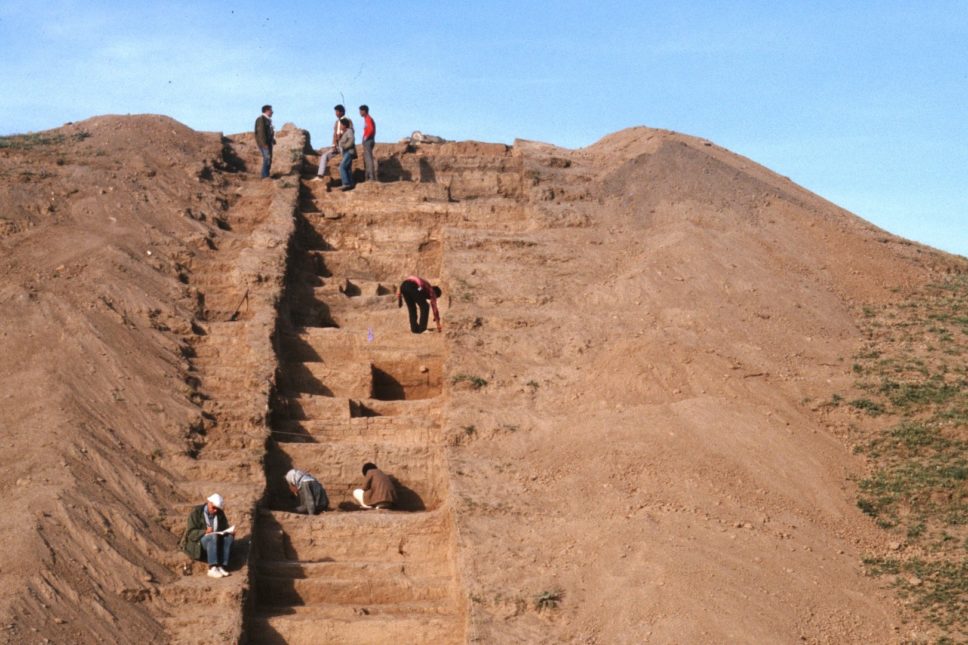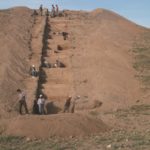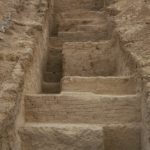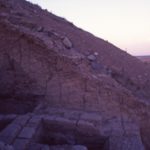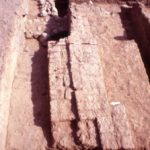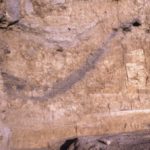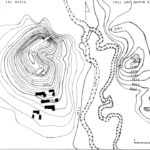Tell Abu Hafur
-
Project name:
Rescue excavations as part of the Western Hassake Dam Project
-
Site type:
Two nearby settlement sites on opposite banks of a wadi: rural settlement, fortified(?) farm
Location:
Syria
Syrian Jazira, Upper Khabur basin (so-called Khabur Triangle)
Upper (Northern) MesopotamiaDating:
– Ubaid period (5th millennium BC)
– Uruk period (end of the 4th millennium BC)
– Early Dynastic II–III period (2800–2300 BC)
– Mitanni period (second half of the 2nd millennium BC)
– Neo-Assyrian period (first half of the 2nd millennium BC)
– Hellenistic period
– Roman–Parthian period
– Early Islamic period
Most interesting finds:
– Relics of domestic architecture from the Early Dynastic period on the main tell and from the Mitanni and Neo-Assyrian periods on the eastern tell
– Pottery from different periods
History of research:
Dates of PCMA research:
1988–1990
Type of research:
Salvage excavations
Project directors:
Maria Krogulska (first season)
Piotr Bieliński (two following seasons)
Partners:
– Polish Centre of Mediterranean Archaeology of the University of Warsaw
– Directorate of Antiquities of the Republic of Syria
Description of site and research results:
The main tell is a steep, conical-shaped hill 20 m high and with surface of about 3 ha, while the other one is only 5 m high and covers about 1 ha. The hills are situated on opposite sides of Wadi Avedji, about 12 km to the north-west of the city of Hassake. At present, they stand on the bank of an artificial water reservoir.
The settling of both hills happened at roughly the same time. The main tell was first inhabited in the Chalcolithic and Early Bronze Age, while the small one in the Late Bronze Age.
Nine archaeological layers were recognized on the main tell (Tell Abu Hafur). The most abundant remains came from the Early Dynastic period, the latest one to be identified on site. They were fragments of four mud-brick houses which stood along a narrow street paved with stones in the domestic quarter on the southeastern slope of the tell. Each house had two to four rooms and a courtyard. Walls and thresholds were covered with clay plaster and floors were made of compacted clay. Typical furnishing included ovens which were always built in the northern or western corner, hearths and clay pools of unknown purpose. Among the houses seven graves were found: three infant burials in vessels, three children’s burials in mud-brick cases and one pit burial with the remains of an adult.
On the northern slope of the hill a fragment of a 6-m thick wall of mud bricks was uncovered. It is not clear if it protected the settlement from being flooded by water from the nearby wadi or if it was just a defense wall.
Later remains of the settlement were found on the smaller hill (Tell Abu Hafur “East”). Relics of a house were dated to the Mitanni period, while remains of a defensive settlement with a wall built on stone foundations to the Neo-Assyrian period. Although the surface of the site was heavily eroded and damaged by modern plowing, fragments of pottery found there indicated that the settlement continued during the Hellenistic, Parthian–Roman and Early Islamic periods. An interesting find which attested to the wealth of the inhabitants of the settlement in the Hellenistic period were sherds of imported Attic black-glazed wares.
Some pottery vessels from Tell Abu Hafur became part of the collection of the National Museum in Warsaw.
Bielińska, D. (2016). A spectacle idol from Tell Abu Hafur (North Syria) and its possible function. Études et Travaux (Centre d’Archéologie Méditerranéenne de l’Académie Polonaise des Sciences), 29, 33–41.
Reiche, A. (2014). Tell Abu Hafur „East”, Tell Arbid (North-Eastern Syria) and Nemrik (Northern Iraq) as Examples of Small-Scale Rural Settlements in Upper Mesopotamia in the Mittani Period. Bonatz, D. (Ed.), The Archaeology of Political Spaces. The Upper Mesopotamian Piedmont in the Second Millennium BC, Berlin, Boston: De Gruyter, 43—60.
Koliński, R. (2004). Tall Abu Hufur, in: Anatasio, S., Lebeau, M., Sauvage, M. (eds.), Atlas of Preclassical Upper Mesopotamia, Subartu, XIII, Turnhout: Brepols 2004, 37.
Reiche, A. (2001). Polish Archaeological Research in Northeastern Syria. Bulletin du Musée National de Varsovie, 42, 95–106.
Koliński, R. (2000). Polish excavations at Tell Abu Hafur, Area A. Season 1990, in: Damaszener Mitteilungen, 12, 31–53
Smogorzewska, A., Daszkiewicz, M. (2000). Archaeological and laboratory study of Metallic Ware from Tell Abu Hafur, Tell Djassa el-Gharbi and Tell Rad Shaqrah (north east Syria), w: K. van Lerberghe, G. Voet (red.), Tell Beydar: Environmental and Technical Studies, Subartu, 6, 173–189.
Reiche, A. (1997). Tell Abu Hafur ‘East’: neuassyrische Besiedlung in der Umgebung von Hasake (Nord-Ost-Syrien), in: H. Waetzoldt and H. Hauptmann, (eds.), Assyrier im Wandel der Zeiten, Heidelberg: Heidelberger Orientverlag, 355–364.
Bieliński, P. (1995). Od Eufratu do Tygrysu i jeszcze dalej, w: M. L. Bernhard (ed.), Od Nilu do Eufratu: polska archeologia śródziemnomorska 1981–1994 (pp. 119–126). Warsaw: PCMA
Koliński, R., & Ławecka, D. (1992). Report of Polish excavations at Tell Abu Hafur, North Syria 1988-1989. Area A. Mitteilungen des Deutschen Archäologischen Instituts. Orient Abteilung – Damaskus (Damaszener Mitteilungen), 6, 177–246.
Bieliński, P. (1991). The third season of excavations in Northeastern Syria – 1990. Polish Archaeology in the Mediterranean, 2, 94–101.
Bieliński, P. (1990). Polish excavations in Northeast Syria 1988–1989. Polish Archaeology in the Mediterranean, 1, 17–25.
Krogulska, M. et alii (1988). Tell Djassa Al-Gharbi, Tell Abu Hafur, Informator Archeologiczny: badania, 22, 158–159.
Gallery:
-
1. Tell Abu Hafur. Stepped trench on the northern slope of the tell. Tell Abu Hafur. Wykop schodkowy na północnym stoku tellu.
-
2. Tell Abu Hafur. Stepped trench on the northern slope of the tell. Tell Abu Hafur. Wykop schodkowy na północnym stoku tellu.
-
3. Tell Abu Hafur. Side view of the trench on the slope. Tell Abu Hafur. wykop na stoku, widziany z boku.
-
4. Tell Abu Hafur “East”. Wall from the Neo-Assyrian period (first half of the 1st millennium BC). Tell Abu Hafur “East”. Mur z okresu nowoasyryjskiego (1. poł. 1 tys. p.n.e.).
-
5. Tell Abu Hafur “East”. Archaeological section of a floor and a wall of a house from the Mitanni period (second half of the 2nd millennium BC). Tell Abu Hafur “East”. Podłoga i ściana domu z okresu Mitanni widziana w przekroju archeologicznym (2. poł. 2 tys. p.n.e.).
-
5. Plan of the site. Plan stanowiska.

